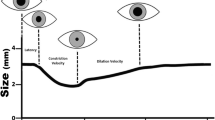Abstract
Post-mortem chemical excitability of the iris is one of the non-temperature-based methods in forensic diagnosis of the time since death. Although several authors reported on their findings, using different measurement methods, currently used time limits are based on a single dissertation which has recently been doubted to be applicable for forensic purpose. We investigated changes in pupil-iris ratio after application of acetylcholine (n = 79) or tropicamide (n = 58) and in controls at upper and lower time limits that are suggested in the current literature, using a digital photography-based measurement method with excellent reliability. We observed “positive,” “negative,” and “paradox” reactions in both intervention and control conditions at all investigated post-mortem time points, suggesting spontaneous changes in pupil size to be causative for the finding. According to our observations, post-mortem chemical excitability of the iris should not be used in forensic death time estimation, as results may cause false conclusions regarding the correct time point of death and might therefore be strongly misleading.


Similar content being viewed by others
References
Madea B (2016) Estimation of the time since death, 3rd edn. CRC Press, New York
Madea B (2016) Methods for determining time of death. Forensic Sci Med Pathol 12:451–485
Henssge C, Madea B (2004) Estimation of the time since death in the early post-mortem period. Forensic Sci Int 144:167–175
Marshall JN (1885) On the changes in the pupil after death. Lancet 126:286–288
Placzek D (1903) Über Pupillenveränderungen nach dem Tode. Virchows Arch Pathol Anat Physiol 173(1):172–204
Willer H (1926) Ergebnisse von Pupillenmessungen an der Leiche. Dtsch Z ges gerichtl Med 6:22–32
Ritter K (1933) Zur Frage der Vitalreaktionen an Leichen. Dtsch Z ges gerichtl Med 20:144–150
Prokop O, Fünfhausen G (1959) Über postmortale Pupillenreaktion auf pharmakologische Reize. Dtsch Z gerichtl Med 49:469–473
Bardzik S (1966) The efficiency of methods of estimating the time of death by pharmacological means. J Forensic Med 13:141–143
Klein A, Klein S (1978) Die Todeszeitbestimmung am menschlichen Auge, Med Akademie Dresden, Medical Dissertation
Orrico M, Melotti R, Mantovani A, Avesani B, de Marco R, de Leo D (2008) Pupil pharmacological reactivity as method for assessing time since death is fallacious. Am J Forensic Med Pathol 29:304–308
Fleischer L, Sehner S, Riemer M, Raupach T, Gehl A, Anders S (2017) Measurement of post-mortem pupil size: a new method with excellent reliability and its application to pupil changes in the early post-mortem period. J Forensic Sci 62(3):791–795
Faller-Marquardt M, Pollak S (1992) Zum Einfluss der Umgebungstemperatur auf den Ablauf der spontanen postmortalen Pupillenveränderungen (Untersuchungen am Kaninchenauge). Beitr Gerichtl Med 50:325–332
Larpkrajang S, Worasuwannarak W, Peonim V, Udnoon J, Srisont S (2016) The use of pilocarpine eye drops for estimating the time since death. J Forensic Legal Med 39:100–103
Warther S, Sehner S, Raupach T, Püschel K, Anders S (2012) Estimation of the time since death: post mortem contractions of human skeletal muscles following mechanical stimulation (idiomuscular contraction). Int J Legal Med 126:399–405
Anders S, Kunz M, Gehl A, Raupach T, Beck-Bornholdt HP (2013) Estimation of the time since death—reconsidering the re-establishment of rigor mortis. Int J Legal Med 127:127–130
Crostak C, Sehner S, Raupach T, Anders S (2017) Re-establishment of rigor mortis: evidence for a considerably longer post-mortem time span. Int J Legal Med 131:1039–1042
Author information
Authors and Affiliations
Corresponding author
Electronic supplementary material
ESM 1
(PDF 217 kb)
Rights and permissions
About this article
Cite this article
Koehler, K., Sehner, S., Riemer, M. et al. Post-mortem chemical excitability of the iris should not be used for forensic death time diagnosis. Int J Legal Med 132, 1693–1697 (2018). https://doi.org/10.1007/s00414-018-1846-0
Received:
Accepted:
Published:
Issue Date:
DOI: https://doi.org/10.1007/s00414-018-1846-0




